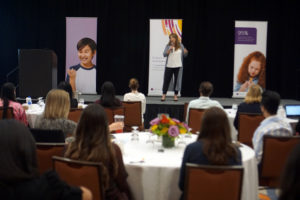August 26, 2021

Michele Andrews, OD, Vice President, Professional and Government Affairs, Americas, CooperVision, welcomes attendees to the Brilliant Futures peer-to-peer workshop.
SAN RAMON, Calif. — CooperVision hosted a Chicago-based workshop August 19-20 for practitioners certified in the Brilliant Futures program in an effort to continue the growth and expansion of myopia management treatments.
During the workshop, attendees discussed parent communication insights, staff engagement strategies, and marketing tips that can enhance practices’ success with the Brilliant Futures Myopia Management Program and MiSight 1 day contact lenses.
“I became a MiSight provider less than a year ago, and now I wanted to take it to the next level with some additional marketing tools and more confidence communicating about it with my age-appropriate* patients and their parents,” said Stacie Setchell, OD, Virdi Eye Clinic. “This workshop was well worth coming to. This has been great.”
Two Brilliant Futures certified ECPs — Maria Liu, OD, PhD, MPH, MBA, FAAO, and Ashley Wallace-Tucker, OD, FAAO — shared their myopia management tips with their peers. Attendees also learned from Steve Vargo, OD, MD, optometric practice management consultant, Tara O’Grady, ALLDOCs managing director, Mike McDougall, APR, Fellow PRSA, president of McDougall Communications, and CooperVision’s Michele Andrews, OD, Justin Kwan, OD, FAAO, and Kelly Volz, OD, FAAO, FSLS.
“Act today to change tomorrow,” said Dr. Kwan, Senior Manager of Myopia Management, CooperVision. “That’s the choice that every Brilliant Futures certified ECP made when they brought the only FDA-approved* myopia control contact lens in children aged 8-12 at the initiation of treatment, MiSight 1 day, into their practices. Now, through partnership, we can grow the impact of their efforts.”
*Indications for use: MiSight® 1 day (omafilcon A) soft (hydrophilic) contact lenses for daily wear are indicated for the correction of myopic ametropia and for slowing the progression of myopia in children with non-diseased eyes, who at the initiation of treatment are 8-12 years of age and have a refraction of -0.75 to -4.00 diopters (spherical equivalent) with ≤ 0.75 diopters of astigmatism. The lens is to be discarded after each removal.













